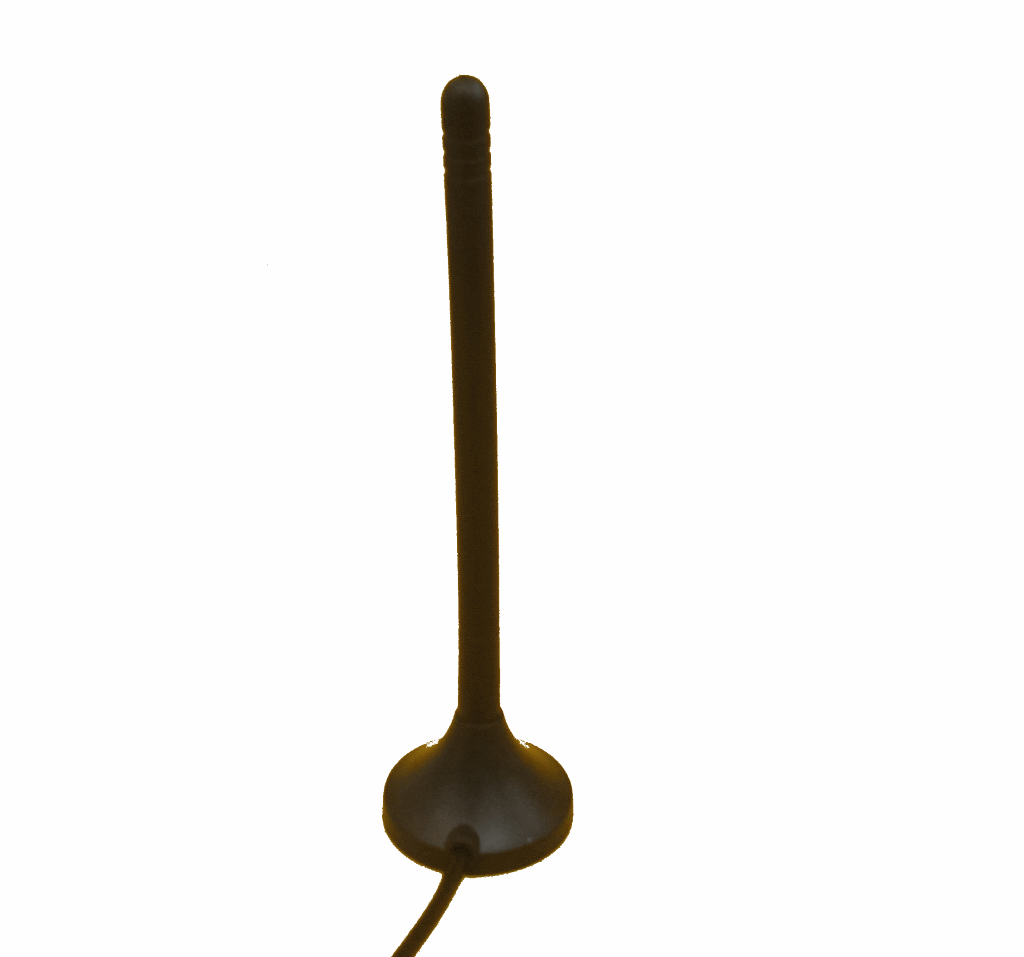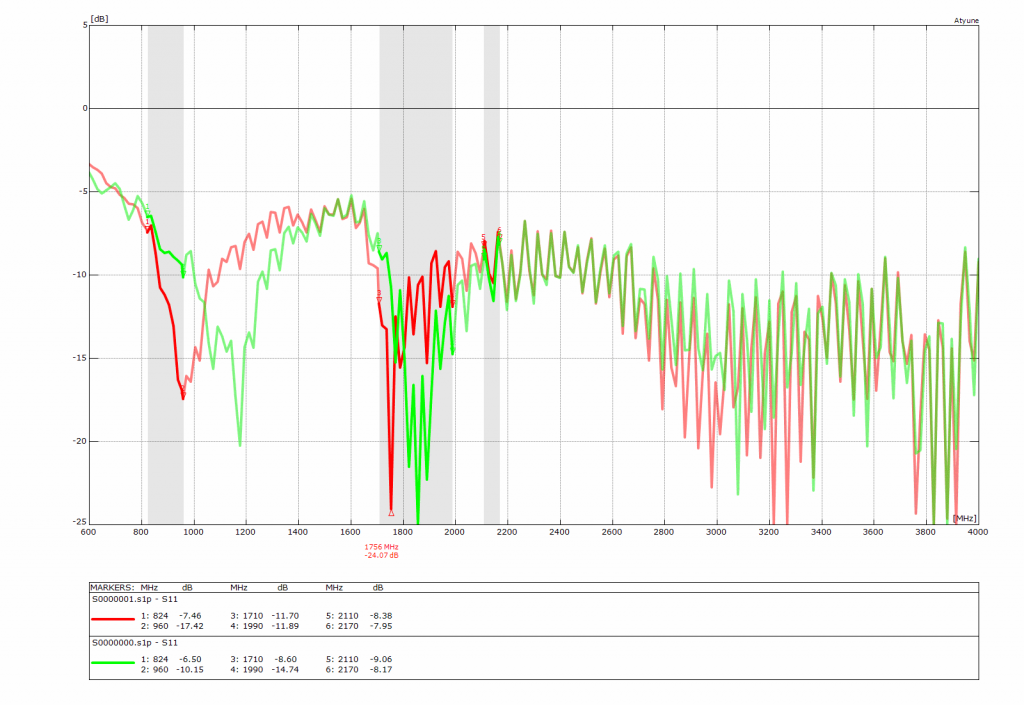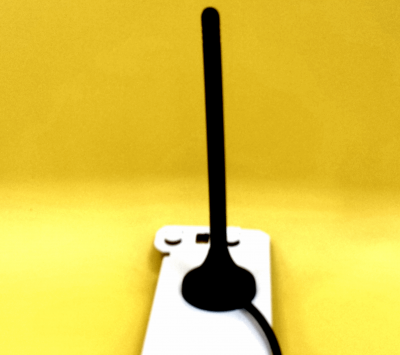Our third patient has a popular name. The manufacturers have called it the magnetic mount antenna. Further details about the third mobile antenna patient are given in the test below.
Here are the medical records of the cellular magnetic mount antenna:
- Frequency bands: GSM 850/900 MHz, GSM 1800 / 1900 MHz, UMTS 2100
- Frequency range: 824 – 960 MHz and 1710 – 2150 MHz
- VSWR @ 824 – 960 MHz max. 2 and VSWR @ 1710 – 2150 MHz max. 2
Return Loss max. in all bands: -9.5 dB - Dimensions: estimated 116 mm length and 30 mm diameter at the magnet
- Cable: RG174
- Cable length: 2 meters
- Connector type: SMA right angle
The data sheet promises a VSWR of 2 in all frequency bands.
Cellular stubby antenna – test in one condition
- Antenna mounted direct to the SMA connector of the VNA in free space
- Antenna mounted direct to the SMA connector of the VNA on a piece of metal
Some initial details:
- VSWR: 2 = Return Loss of – 9.5 dB
- VSWR: 3 = Return Loss of – 6 dB
You can calculate this yourself here http://cgi.www.telestrian.co.uk/cgi-bin/www.telestrian.co.uk/vswr.pl
A VSWR of 2 is the common minimum for magnetic cellular antennas.
Cellular stubby antenna – free space and on metal
Red line not matched
- 824 MHz = RL -7.46 dB / 1710 MHz = RL -11.70 dB / 2110 MHz = -8.38 dB
- 960 MHz = RL -6.50 dB / 1990 MHz = RL -11.89 dB / 2170 MHz = -7.95 dB
Green line mounted on metal
- 824 MHz = RL -6.50 dB / 1710 MHz = RL -8.60 dB / 2110 MHz = -9.06 dB
- 960 MHz = RL -10.15 dB / 1990 MHz = RL -14.74 dB / 2170 MHz = -8.17 dB
The gap between two – 6 dB or – 9.5 dB markers is called the -6 dBm or -10 dB bandwidth. A -10 dB bandwidth, equal to a VSWR of 2, is the goal of any antenna designer. Magnetic mount antennas mounted with coaxial cables should cover the -10 dB bandwidth.
The green graph shows that the magnetic mount antenna without metal behind the magnet is completely detuned at the lower GSM band. The -10 dB Return Loss bandwidth is from an estimated 1000 MHz up to 1250 MHz. They grey shadowed zone shows where we expect the – 10 dB bandwidth. At the upper cellular bands the -10 dB bandwidth looks okay.
The red graph shows the antenna mounted on some metal. At the lower band the graph jumps in the right direction, but is still not matching the promised -10 dB bandwidth in the grey zone. At the upper bands the magnetic mount antenna does not look too bad. Even the LTE 2600 band is covered. The antenna does not always meet the -10 dB but is better than -6 dB Return Loss most of the time.
Necessary bandwidth in cellular bands
-
- Bandwidth in GSM 850/900 => 960 MHz – 824 MHz = 136 Mhz
-
- Bandwidth in GSM 900 => 960 MHz – 880 MHz = 80 Mhz
-
- Bandwidth in GSM 1800/1900 = 1990 MHz – 1710 MHz = 280 MHz
-
- Bandwidth in GSM 1800 = 1880 MHz – 1710 MHz = 170 MHz
-
- Bandwidth in UMTS 2100 = 2170 MHz – 2110 MHz = 60 MHz
- Bandwidth GSM1800/1900 + UMTS 2100 = 2170 MHz – 1710 MHz = 460 MHz
If you have a need for dual-band GSM only, then the bandwidth of 80 MHz for GSM 900 and 170 MHz for GSM1800 is much easier to cover than the quad-band GSM plus UMTS 2100 with its 136 MHz at the lower band and 460 MHz at the higher bands.
Some quick questions to consider:
- Why did the manufacturer of the antenna ship a detuned antenna?
- Why did the manufacturer of the antenna place no metal behind the magnet?
- Why did the manufacturer of the antenna promise a VSWR of 2 but can not keep that promises?
Your magnetic mount cellular antenna – mounted on metal
Your magnetic mount antenna will surely behave differently from these test conditions. If we test the same cellular magnet antenna in your unique environment, then we would expect to get a different result. However on a big metal plate you can expect to get the promised values listed in the data sheet.
The result will affected by, for example:
-
- Big metal plate behind the magnet
-
- Small metal plate behind the magnet
- No metal plate behind the magnet
Based on this fact, I came to the conclusion that an antenna test service would be a valuable offering. During my customer visits I am able to offer you a quick test, often free of charge. I will come with my mobile vector network analyser (VNA) to your office. The cellular magnetic mount antenna in this article was tested at the customer site. I need a few minutes to power on the mobile VNA and the laptop . The VNA self-calibrates on its SMA adapters. The calibration takes only few seconds. Once this task is done I can test several antennas in a row for you very quickly. The analysis of the graph takes more time then the measurement itself.
If you have a patient for the Antenna Hospital or the Antenna Ambulance then do not hesitate to drop an email to harald.naumann (at) gsm-modem.de


